 |
| 世界の菱マンガン鉱ルース (Faceted rhodochrosite from world's locality) 0.25 −39.51ct |
菱マンガン鉱(Rhodochrosite)
 |
| 世界の菱マンガン鉱ルース (Faceted rhodochrosite from world's locality) 0.25 −39.51ct |
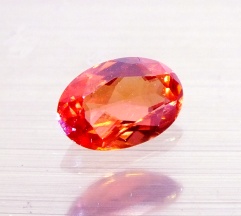 |
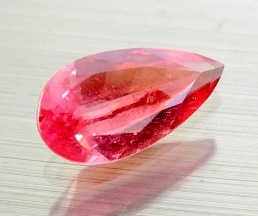 |
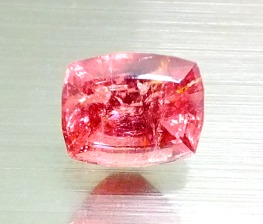 |
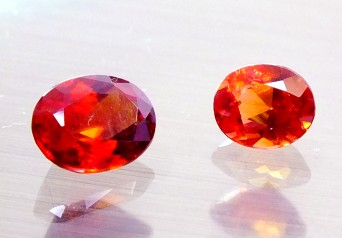 |
 |
| 1.93ct 8.6x6.5mm | 3.73ct 15x8mm | 4.17ct 10.2x8mm | 1.4ct 8.5x6mm, 1.1ct 6.9x5.9mm | 2.85ct Ø8.1mm |
| Sweet Home Mine, Alma, Colorado, U.S.A. | 茨城県高取鉱山 Takatori Mine, Ibaragi, Japan |
Uchucchacua Mine, Oyon, Lima Distric, Peru |
||
 |
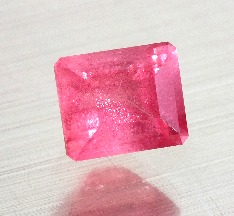 |
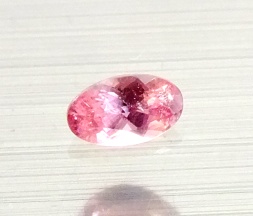 |
| 0.67ct 6.1x4mm 0.31ct 5.0x3.1mm | 4.80ct 9.7x8.2x6.2mm | 0.28ct 5.0x3.1mm |
| Mont St. Hilaire, Quebec, Canada | 中国江西省 チュアン族自治区 武東鉱山 (Wutong Mine, China) | |
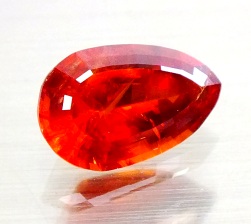 |
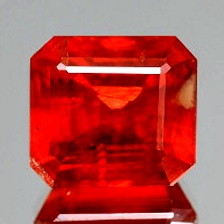 |
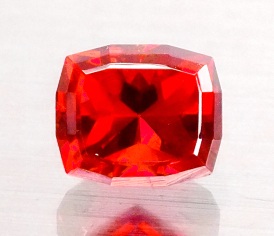 |
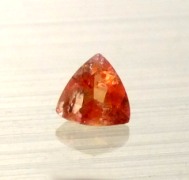 |
| 6.11ct 14.5x9.5x6.0mm | 6.6ct 10.1x9.2x7.4mm | 4.22ct 9.2x7.9x6.8mm | 0.25ct 3.8mm |
| N'Chwaning Mine, Kurman, South Africa | |||
| 化学組成 (Chemical Composition) |
結晶系 (Crystal System) |
結晶形 (Crystal Form) |
モース硬度 (Hardness) |
比重 (Density) |
屈折率 (Refractive Index) | |
| MnCO3 | 三方晶系 (Trigonal) |
 |
 |
4 | 3.40-70 | 1.60-82 |
名前と産状(Name and Occurence)
ロードクロサイト(菱マンガン鉱)の名前はギリシア語の ”rhodon=薔薇とkhroma=色” に由来し、1813年にドイツの鉱物学者J.F.L. ハウスマンによって命名されました。日本名は結晶が見事な菱形の面を示すことに由来します。
菱マンガン鉱は主に銀、鉛、亜鉛、タングステン等、中低温の熱水性の重金属鉱床の鉱脈に脈石として発見されます。
また堆積鉱床、変成鉱床等には高温の熱水型として、稀に末期の熱水性のペグマタイト鉱床等、広範な産状で発見される鉱物です。
一般には団塊状、粒状、或いは葡萄状、同心円状等多彩な姿で産します。後述する世界各地の鉱山からの菱面体や犬牙状の透明な美しい結晶は鉱物収集家の垂涎の的となっています。
マンガン・イオンにより美しいピンクの発色となりますが、微量の鉄分が混入すると橙色〜濃い赤となります。
Rhodochrosite's name derives from Greek, "rhodon=rose and khroma=color" for it's color, named by German geologist Johann Friedrich Ludwig Hausmann. Rhodochrosite commonly occus as a gangue mineral in medium-and-low temperature hydrothermal veins, or in high temperature metasomatic deposits and sedimentary manganese deposits, or rarely as a late stage hydrothermal mineral in pegmatite.
In general, rhodochrosite is found massive, granular, and botryoidal aggregates forms. Transparent rhombohedral and scalenohedral crystals, recovered from below-mentioned localities are the most seeked after by collectors.
The attractive rose color derives from manganese ion and minor iron impurity results in deep red color.
スイート・ホーム鉱山 (Sweet Home Mine) Alma, Colorado U.S.A.
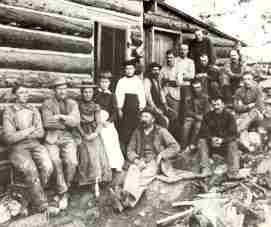 |
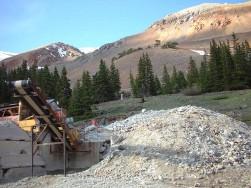 |
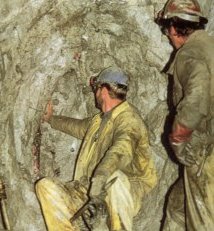 |
 |
| 1896年当時の鉱夫達
Mining crews of Sweet Home Mine |
2003年の鉱山 背景はモスキート山地 Mine in 2003 in Mosquito Range |
菱マンガン鉱晶洞とデンバー自然史博物館の展示 Rhodochrosite pocket and display at Denver Museum of Natural HIstory, Colorado, U.S.A. | |
2008 Tucson Show " Great American Minerals " Sweet Home Mine Rhodochrosites
スイートホーム鉱山はロッキー山脈の中央,コロラド州デンバーから西南西へ128kmのモスキート山脈の中腹、アルマの町に近い標高3350mの地点にあります。
操業当初はホーム・スイート・ホーム鉱山と呼ばれた銀鉱山は1872年から1960年代までの90年間、断続的に操業していました。
が時折、晶洞と呼ばれる鉱脈の空間を埋めて産出する菱マンガン鉱の美晶が次第に注目を集めるようになりました。
1887年にはティファニー宝石店のクンツ博士がこの結晶を宝石用途としても注目して報告しているほどです。
周囲には他にも菱マンガン鉱の結晶を産出する多数の金や銀の鉱山がありますが、スウィート・ホーム鉱山の結晶は質、量共に他を圧倒するものでした。
菱マンガン鉱の生成は、マンガン、硫黄,炭素,酸素や弗素を含む熱水が鉱脈の割れ目を充たし、熱水の温度が300℃に下がった時に結晶したものと考えられています。
スイートホーム鉱山は銀山としては60年代に閉鎖されましたが、1991年に純粋に菱マンガン鉱の結晶採取を目的に、300万ドルを投下して再開され、1992年には早くも The Alma King と名付けられた一辺の長さ14cm巨大な結晶が発見されました。
この標本はデンヴァー自然史博物館に展示されています。
しかしながら結晶は期待されていたほどには発見出来ず、鉱山は2000年初めに閉鎖されました。
したがって現在市場には古い在庫やコレクターの放出品が限られた量出回るのみとなっています。
The Sweet Home mine lies near the small town of Alma, at about 3350m above see level in the rugged Mosquito Range about 128km southwest of Dever, Colorad.
The mine (first called as The Home Seeet Home mine) operated for siliver since 1872 to 1960's. As in case of other localities, although rhodochrosite is only a bi-products of metal resources, crystals found in the cavity became famous in lator years.
In 1887, Dr. George F. Kunz of Tiffany & Company reported finding gem-quality rhodochrosite in Colorado, "the first locality to yield crystals of such magnitude and transparency." Though rhodochrosite crystals occurs in many gold, silver and molybdenum mines in this area, taht of Sweet Home mine's were outstanding both for quality and volumes.
Rhodochrosite is deposited from hydrothermal solutions containing metal ions, sulfer, carbon, oxygen, fluorine and manganese. The solutions work their way through fissures and when the solutions cools at about 300℃, rhodochrosite crystalizes along the cavity walls. The Sweet Home silver mine was closed in 1960's but reopened in 1991 under an ambitious effort to uncover and extract fine rhodochrosite specimens, with capital of US$ 3million. The challenge resulted in the discovery of the largest sopecimen called "the Alma King : a crystal measuring 14cm that sits on a matrix of quartz over 65cm", which is now in the collection of the Denver Museum of Natural History. Hoever, total crystal collection has been far less than expected both by volume and quality and the mine was closed in early 2000's.
右の結晶の鉱脈中の状態
(Rhodochrosite crystal in a pocket)酸とエアブラシで洗浄後 14x12cm
(After cleaning of silica and mud
coating by acid and air abrasion)21x10x10mm 3.73ct 15x8mm 17x13mm
酸やブラシで慎重に処理、洗浄して初めて結晶が美しい姿を現すのです。
Rhodochrosite crystals are not spectacular when recovered at the vein. They reveal their real beauty after careful trimming and cleaning by combinations of acid and air abrasion.
ペルーの菱マンガン鉱(Rhdochrosites from Peru)
9x8cm スミソニアン博物館
Smithsonian Institution Collection12.5cm
Bruce Dreck Collection葡萄状と菱面体結晶 48x38x34mm
Botryoidal and rhombohedral
rhodochrosite crystal matrix結晶(crystal)19x9mm
ルース 1.4 1.1ctHuallapon Mine Uchucchacua Mine, Oyon, Lima District, Peru
1. Quiruvilca Ditrict 3800 - 4000m 2. Pasto Bueno District
Huallapon, La magistral,
Mundo Nuevo, Tamboras3300 - 5000m 3. Raura District 4. Pachapaqui District 3800 - 4500m 5. Huanzala Mine 6. Uchucchacua Mine 4500 - 4800m 7. Cerro de Pasco Mine 8. Huaron Mines(20 mines) 4300 - 4800m 9. Morococha District 4400m 10. Casapalca District 4400m 11. Pampa Blanca Areas 12. Julcani District 4200m 13. Gastrorireyna District 5000m
南アメリカの西海岸に並行して総延長7500km、幅500kmに及ぶアンデス山脈は世界的な金属鉱床の宝庫です。
ペルーのアンデス山脈にも延長1000kmに渡って無数の鉱山群があります。
上の地図は13の主要な金、銀、銅、鉛、亜鉛、タングステン、モリブデン、マンガン等を鉱山群の位置が示されています。
赤字で示された9ヶ所の鉱山群が菱マンガン鉱を産します。
中でも首都リマの北400kmの2.パスト・ブエノ地区のワジャポン(Huallapon)鉱山とリマの北100kmの6.ウチュクチャクア(Uchucchacua Mine)鉱山はコロラドのスイート・ホーム鉱山産と肩を並べる透明な美しい大型結晶を産します。
The Andes, which lie along western coast of South America for 7500km long and 500km wide, is rich in heavy metal resources. In Peruvian Andes, numerous mines exist along 1000km long. The map shows 13 major locations of mineralizing group of gole, silver, copper, lead, zinc, tin, tungsten, molybdenum, manganese, etc. Nine localities produce rhodochrosite. Particulary, Huallapon mine in Pasto Bueno District, 400km north from Lima and Uchucchacua mine produce superb gemmy rhodocchrosite crystals, equivalent to that from Sweet Home mine, Colorado, U.S.A.
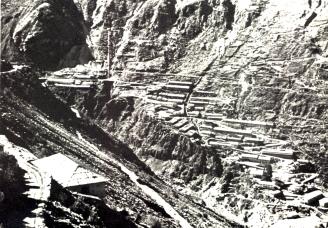 |
 |
| 標高4500mのアンデス地帯の鉱山Huallapon鉱山への道路 Mountain road to Huallapon Mine, 4500m in Andes Mountains | |
ワジャポン鉱山(Huallapon Mine)
アンデス山中のパスト・ブエノ地方にタングステン、モリブデン、金、銀、銅と豊かな金属鉱床が発見されたのは19世紀初頭のことでした。
標高4500mのワジャポン鉱山のタングステン鉱床も発見は1910年に遡りますが、無人の山岳地帯のために開発が始まったのは1934年、近代的な設備による本格的な採掘の開始は1970年代と最近のことです。
1980年頃から鉱脈のポケット(晶洞)に菱マンガン鉱結晶、マンガン重石: MnWO4 ,紫の燐灰石、緑や茶色の閃亜鉛鉱、安四面銅鉱、菱鉄鉱、方鉛鉱、黄鉄鉱、方解石等の世界的な水準の美しい結晶が発見され始めました。
これらの結晶を目当てに、世界の鉱物標本商がはるばると,この地の果ての鉱山を訪れ、坑道の入り口で鉱夫達が素晴らしい結晶を持って出てくるのを辛抱強く待っている光景が見られるのです。
個々の菱マンガン鉱の結晶は冒頭の写真のような博物館級は本当に稀ですが、小さなルースがカット出来るような結晶はかなり市場に出まわっています。結晶はスイートホーム鉱山産のものよりよりさらに輝かしい光沢を示します。
The Pasto Bueno mining region was recognized as a potential source of copper, lead, silver, gold, tungsten, and molybdenum early in the 19th century. But high elevation of 4500m, a lack of denpendable labor, remoteness, and excessively rugged country retarded major development. Good quantities of tungsten minerals were discovered in 1910, but mining effors remained desultory, and the mines were closed for long periods. In 1934 a Peruvian company reopened the Huallapon with some success. The mining with modern equipments started in 1970's to emarge incredibly beautiful crystals of rhodochrosite, huebnerite, purple apatite, green and brown sphalerite, tetrahedrite, siderite, pyrite, galena, enargit, calcite and dolomite. These crystals rank quite favorably with their counterparts from other localities, and these specimens now surface to find a ready market- frequently represented by mineral dealers patiently waiting at Huallapon's portals. Huallapon rhodochrosite nearly matches the red of the best specimens from Alma, Colorado, and their brilliant luster surpasses the Alma material.
ウチュクチャクア鉱山(Uchucchacua Mine)
ウチュクチャクア鉱山はペルーの首都リマ地域のオヨン地方、標高4500−5100mのアンデス山中のスカルン型交代鉱床の銀ーマンガンー鉛ー亜鉛鉱山です。
この鉱山産の菱マンガン鉱は濃いワイン色と犬牙状の宝石質の結晶で有名です。
その品質はコロラドのスイート・ホーム鉱山及び南アフリカのンチュアニン鉱山産と並ぶ屈指の水準です。
現在操業中で最も高品質の宝石質の菱マンガン鉱を産する鉱山です。
Uchucchacua mine is a silver-manganese-lead-zinc replacement vein in skarn district located at elevation of 4500 to 5100m in the Andes Mountains, in Oyon Province, Lima District, Peru. This mine is famous among collectors for the rhodochrosite crystal of gemmy quality and scalenohedral shape, the only ones can compete with the Sweet Home mine and N'Chwaning mine, South Africa.
南アフリカ ンチュワニン鉱山(N'Chwaning Mine, South Africa)
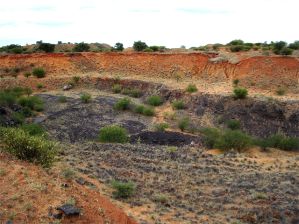 |
 |
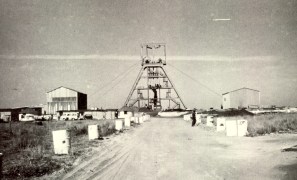 |
| 地下のマンガン鉱床の開発光景 Smartt Prospecting area |
マンガン鉱床の露頭 Manganese outcrops |
ンチュワニン鉱山縦坑入り口 Entrance to N'Chwaning Mine |
| Near smartt, 30km south of Hotazel, Kalahai Manganese Field | ||
6.5x5.5cm
Bill Larson Collection5x4cm
Norman Pellman Collection結晶(Crystal)5x2cm
大きいルース 12.5ct
David Eidahl Collection24mm 10x8cm
Keith Proctor Collection
南アフリカのカラハリ砂漠地帯にて1922年に Black Rockと呼ばれる地点にマンガン鉱床の露頭が発見されました。
ボーリングの結果、鉱床は砂漠の地下1100平方kmに広がり、推定埋蔵量は80億トンと世界の40〜80%に相当する巨大な鉱床と判明し、カラハリ・マンガン・ベルトとして世界にその名が知れ渡ったのです。
その中心の町クルマン周囲には Hotazel, Wessel, N'chwaning 等、世界的なマンガン鉱山が多数存在し、現在も年間数百万トンのマンガン鉱を産出しています。
鉱床はおよそ13億年前にこの一帯に起こった広範な熱水作用によって純度の高いマンガン鉱床と150種類にも達する多彩な鉱物種の生成がもたらされたと考えられています。
1961年、Hotazel 鉱山から長さ5cmに達する犬牙状、菱面体等の深紅の結晶が多数発見され、世界の鉱物界の話題を呼びましたが1963年には枯渇し、その後の発見は途絶えました。
1975年、Black Rockの東、ンチュワニンに新たな地下のマンガン鉱山が開かれました。
1976年初頭、地下数十メートル地点に方解石、軟マンガン鉱、玉髄、硬石膏と紫の霰石と共に、ワイン・レッド色の菱マンガン鉱の結晶で満たされたポケット群に遭遇しました。
ポケットは小さいものが大半でしたが中には50cmx1mの100kgもの菱マンガン鉱の結晶塊が採取されました。
この標本はプレトリア博物館に展示されています。
この地の結晶は他の産地と異なり,主に犬牙状が多く,その他10以上の多様な結晶形を示し、さらに高い透明度と、ワインのような深紅の色が特徴です。
この産出も一時的なもので、その後ポケットの発見はありませんが、古い在庫から結晶標本やカットされた石が市場に供給されています。
新鉱山の開発は現在も活発に行われていますから、今後も新たな菱マンガン鉱結晶の晶洞が発見される可能性があります。
In 1922, manganese outcrops was discovered at Black Rock, in the Kalahari desert. Exploratory drilling in the region revealed enourmously rich manganese lodes at Wessels, Gloria, and N'Chwaning, which today operate as large underground mines to produce several millions tons of manganese ore. The manganese zones of the Kalahari field contain estimated up to 8 billions of tons, which is considered 40 to 80% of known world reserves.
About 1300 millions years ago, a widespread hydrothermal event occured in the north-western portion of the Kalahari manganese fied, which resulted in an unusal high grade manganese ore body and creation of varieties of minerals up to 150 species.
During 1961 and 1962, the Hotazel caused a sensation in mineral circles when it produced a large number of bright red rhodochrosite crystals formed as druges, scalenohedrons, rhombohedrons, and aggregate dundles of slender prisms, which were mined out in 1963 and no important crystals have been found since that time. In 1975, a new mine opened near Black Rock called N'Chwaning, and early in 1976, vugs filled with wine red rhodochrosite crystals of great beauty were encountered at few hundred feet from the surface, associated with calcite, manganite, chalcedony, gypsum and mauve aragonite. Generally the pockets were small- the most spectacular encountered was about 0.5 by 1m in size, weighed over 100kg and is at present displayed in a Pretoria museum. Many rhodochrosite crystals from N'Chwaning form as scalenohedrons, while most crystals from other sources are rhombohedral and in at least 10 vaiations of crystal habit, many of an unusal wine-red color quite apart from the usual pink to red hues. So far no further occurences of any significance have been found.
カナダ モン・サン・チレール (Mont Saint Hilaire, Quebec, Canada)
カナダのケベック州都、モンレアルから東へ40km程の地にモン・サン・チレール採石場があります。 この採石場は1959年に舗装道路やコンクリート資材の採石場として開発が始まりました。
1963年に鉱物愛好家が珍しい鉱物を採集し、大学の専門家に見せたことから、この採石場が世界で稀に見る稀少鉱物産地であることが判明しました。閃長岩ペグマタイトと呼ばれる鉱脈から400種近い稀少鉱物が続々と発見されています。種類が多いだけではなく、他の産地では単なる鉱物標本に過ぎないような稀少な鉱物が宝石質の大きく美しい結晶として発見されるのです。
菱マンガン鉱はペグマタイト起源の熱水鉱脈にも産するのですが、しかし宝石質の結晶はペグマタイトには極めて稀です。 モン・サン・チレールでは小さいながら、稀にカットできるような結晶が発見されます。6.5mm 0.67ct 0.31ct 7mm
アルゼンチン カピジータス鉱山(Capillitas Mine, Catamarca, Argentina)
鉱山全景
(Capillitas mine general view)坑道入り口
(Entrans to the mine)菱マンガン鉱脈
(Rhodochrosite vein)菱マンガン鉱装飾工芸品
(Carved rhodochrosite)
1986年12月に発見された巨大な晶洞 長さ5m、直径50cm
(Giant cavitry discovered in 1986 with huge scalactites up to 5m long and 0.5m thick)研磨された鍾乳石状菱マンガン鉱
(Polishied scalactic rhodochrosite)
美しい単結晶ではありませんが、不透明から亜透明の菱マンガン鉱がアルゼンチンのアンデス山脈のカタマルカ地方、標高3000mのカピジータス鉱山から産出します。
インカの時代には金山として、またスペインの植民地の時代には銅山として稼動していた鉱山です。
その後イギリスやドイツ資本による経営を経て1981年に日本の資本が参加し、金,銀,銅の精錬と共に、インカの時代からインカ・ローズとして知られていた菱マンガン鉱も活用しようというプロジェクトが始まりました。
カピジータス鉱山から副産物として,年間2〜300トン採れる菱マンガン鉱は美しい色彩と、同心円状の模様とで、彫刻用,飾り物、また手軽な装飾品へと加工され、広く世界に出まわっていますから、何処かでご覧になった方もあるでしょう。
The polymetallic sulfied veins of Capillitas mine, located high at 3000 to 3300m in the Andes Mountains, Argentine, have been mined since the times of the Incas. Lator mining activity continued under the Spaniards, English, Germans and since 1981 by Japanese capital for gold, silver and copper.
Rhodochrosite of Capillitas mine, a major bi-products of the vein, has been know since the times of Incas as "Inca-Rose" and has been polished for ornamental purpose. Today, 200 to 300 tons of rhodochrosite are collected and carved.
日本の菱マンガン鉱 (Rhodochrosite from Japan)
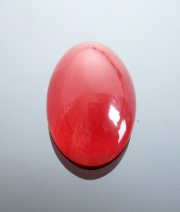 |
 |
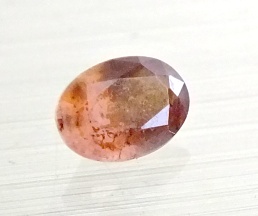 |
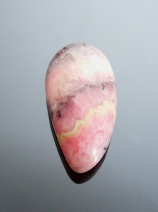 |
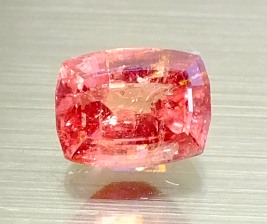 |
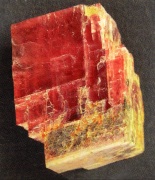 |
 |
| 39.51ct 25x17mm 0.56ct 6.1x4.2x3.1mm 0.67ct 6.2x4.4x3.4mm 北海道・稲倉石鉱山 Inakuraishi Mine, Hokkaido |
22.64ct
29x15mm 北海道・八雲鉱山 Yakumo Mine, Hokkaido |
4.17ct 10.2x8mm | 宝石質結晶 50mm Gemmy Crystal |
青森県尾太鉱山の菱マンガン鉱 Oppu Mine, Aomori, Japan | ||
| 茨城県 高取鉱山 (Takatori Mine, Ibaragi) | ||||||
かつて日本でも各種の金属鉱山が全盛時代には、世界の水準と並ぶ見事な鉱物を産出したことがあります。
菱マンガン鉱も、上述の産地には及びませんが、しかし北海道八雲鉱山、稲倉石鉱山、青森県尾太鉱山、秋田県尾去沢鉱山、石川県倉谷鉱山、茨城県高取鉱山等々、多くの鉱山から世界水準の標本を産したものです。
これらの鉱山はいずれも熱水型の金属鉱床で、金、銀、銅、鉛、亜鉛、錫、マンガン、タングステン等の重金属鉱床の鉱脈の間隙に美しい菱マンガン鉱が葡萄状、菱面体結晶、或いは団塊状、繊維状で産出しました。
いずれの鉱山も遠の昔に閉山してしまいましたが、何処かに鉱石の在庫が残っているようで時折鉱物標本や研磨された品が出回ります。 2003年6月の東京国際ミネラルフェアで、そうした日本産の宝石がまとまって出品されていました。
2003年12月に池袋での国際化石鉱物ショーにも,思いもかけない日本産の菱マンガン鉱のファセットが出品されていました。
茨城県,高取鉱山産のルースです。少しインクルージョンがありますが,色合い,透明度ともにコロラドのスイート・ホーム鉱山産を彷彿とさせる見事なものです。
恒例の企画展は日本産鉱石でしたが,国産の宝石も展示されていました。
大半はカボション級ですが,岐阜県,苗木のトパーズや水晶等のファセット級ルースは当然ながら,茨城県高取鉱山産の2cmを越える大きさの透明な菱マンガン鉱の結晶と共に小さな2カラット程のルースも展示してありました。
奇しくも同じ会場で2点のルースが販売されていました。上記の写真はそのうちの一つです。
恐らく1960年代に産出した結晶をファセットカットしたものと思われますが,国産のロードクロサイトのルースとしては空前の標本です。
Although small islands, Japan is relatively rich in mineral resources. Until 1960's, considerable numbers of mines have been actively producing varieties of mineral resources, throughout the country. Manganese mine is not the exception ; Yagumo and Inakuraishi mine in Hokkaido, Oppu mine in Aomori, Osarizawa mine in Akita, Kuratani mine inIshikawa, Takatori mine in Ibaragi, produced world class rhodochrosite crystals, not as spectacular as before-mentioned mines but sufficiently world class crystals in rhombohedral, botryoidal, massive or fibrous shapes formed in pockets of gold, silver, copper, lead, zinc, tin, tangusten, molybdenum ores. All mines are now closed but there are limited but stable supply of specimens and carved cabochons from old stock. There were even faceted stones, fairly comparable to Sweet Home stones, from 40 year old stock from Takatori mine, Ibaragi, at 2003 Mineral Show at Ikebukuro, Tokyo.
中国の菱マンガン鉱
"The Emperer of China"
60x40cm 63.5kg"The Empress of China"
39x33cm10.67 - 29.56ct 4.80ct 9.7x8.2x6.2mm 中国広西荘(チュアン)族自治区 梧州市 武東鉱山(Wutong Mine) China
上記のコロラドのスイート・ホーム鉱山、ペルー鉱山、南アフリカ、日本各地の鉱山と、いずれも鉱脈が枯渇したり、閉山になってしまい、古い在庫が細々と結晶標本とルースとが市場に供給されるのみです。
そんな状況下で、ごく最近、中国で新しい鉱脈が発見されました。 広西壮(チュアン)族自治区,梧洲市の 武東鉱山です。
この鉱山は1958年に発見された鉛、亜鉛、銀鉱山ですが、2000年初め頃から濃ピンク色の菱マンガン鉱脈が採れ始めました。
2010年4月には写真のような”中国の皇帝”、”中国の王妃”と呼ばれる巨大な結晶群を産する晶洞が発見され,他の晶洞からも紫や青い蛍石を伴う濃ピンク色の菱マンガン鉱結晶群が数多く採取されました。
産出状況はスイート・ホーム鉱山とよく似た地質条件であると考えられます。が、巨大な結晶は色こそ濃いのですが、一旦出来た結晶の表面を覆うように新たな菱マンガン鉱が低温で再結晶し、そのために20cmを超える程の巨大ではあるものの、不純物や亀裂の多い不透明な結晶になってしまったと考えられます。
結晶の内部に透明な部分が現れることもあり、30カラットを超える大きなルースもカットされています。が、一か八かで巨大な結晶を割るのはあまりにもリスクが大きく、結局 Wutong 鉱山産菱マンガン鉱のルースは殆ど市場に姿を見せないか、あるいは稀に見かけるのは1カラット未満のごく小さく貧弱なルースが大半でした。 が、発見から20年後の2020年にやや包有物が多く、透明度に欠けのですが、4.76カラットと菱マンガン鉱としてはかなりの大きさのルースに出会いました。
結晶の行方 ( If gemmy crystals were broken for cutting ?)
数ある鉱物の中で菱マンガン鉱はその色合いと犬牙状、菱面体の結晶の姿の美しさとでとりわけ魅力があり貴重なものです。
それが冒頭の写真のようにカットされてしまうのはけしからぬことと、鉱物結晶コレクターの方々が憤慨されるかもしれません。確かにかつてブラジルのペグマタイトではアクアマリンやトルマリン等の素晴らしい結晶が採掘時の爆破で粉々になったり、無事に採集されても、その大半が宝飾用にカットされ、残らず失われてしまった例が少なくありません。
ただし菱マンガン鉱に限ってはその心配は無用です。何故ならモース硬度が4と低く傷つき易いこと、更に完全な劈開性のためにカットが大変難しい鉱物でもあります。したがって少しの衝撃で欠け易いこと等、宝飾品としての用途はネックレス等ごく限られています。
美しい色合いと、高い屈折率と大きな副屈折とで美しく光り輝くロードクロサイトですが、もっぱら眺めて楽しむだけの宝石です。そのため市場性が低く、結晶標本としては価値の無い結晶片の透明な部分が時折腕に覚えのあるカッターによって磨かれるだけと言うのが実情です。その数は0.5カラット以上の石が多くても年間100個程度に過ぎないと考えられます。したがって値段もカラット当たり100ドル程度が国際的な相場でした。
が、近年殆どの鉱山が閉山となり、カットが可能な結晶の在庫が少なくなるにつれ、、結晶標本と共にルースの値段が急激に高騰し、一般のコレクターには手が出ない水準になってきています。
Rhodochrosite crystal is one of the most valuable for their attractive color and crystal forms, among all mineral crystals. Some mineral collectors might be angry for faceted stones. In the past, almost all outstanding aquamarine and tourmaline crystals have been destroyed because of blasting at mining and survived crystals were entirely lost for cutting.
Please do not worry, however, for rhodochrosite crystals. Because of their rarity and attractiveness, most gem-quality rhodochrosite crystals are preserved as specimens and not submitted to the lapidary. Neverthless, approximately a hundred 0.5+ ct stones a year are cut from crystals that had been damaged or were otherwise inappropriate for specimen use.